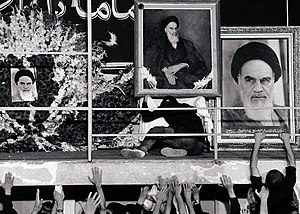Death and state funeral of Ruhollah Khomeini
 Mourning men in residency of Khomeini around his seat area, Jamaran. | |
| Date | 5–6 June 1989 |
|---|---|
| Location | Musalla, Tehran, Iran (Public viewing) Behesht-e Zahra cemetery (Burial) |
| Participants | Iranian officials and clerics, relatives and millions of followers. |
On 3 June 1989, at 22:20 IRST, Grand Ayatollah Ruhollah Khomeini, leader of the Iranian Revolution and the first Supreme Leader and founder of the Islamic Republic of Iran, died in Jamaran, Greater Tehran aged 86 after spending eleven days at a private hospital, near his residency, after suffering five heart attacks in ten days.[1][2] Other sources put his age at 89, and list the cause of death as bleeding in the digestive system.[3]
Khomeini was given a state funeral and then buried at the Behesht-e Zahra (The Paradise of Zahra) cemetery in south Tehran.[4] It was also estimated that 10 (to 17) million people participated in his funeral, and it is named as the largest funeral throughout the world.[citation needed]
Funeral service[]
The first funeral[]
On 5 June, the coffin with Khomeini's body was transferred to the Musalla, a vacant lot in north Tehran. The body was displayed there on a high podium made out of steel shipping containers, in an air-conditioned glass case, wrapped in a white shroud. It stayed there until the next day. Hundreds of thousands of mourners had seen the body.[1] On 6 June, the body was brought down and the coffin opened for Grand Ayatollah Mohammad-Reza Golpaygani to lead the Salat al-Janazah (funeral prayer), which lasted for 20 minutes.[5] Afterwards, since the crowds of mourners had swelled overnight to several millions, it was impossible to deliver the body to the cemetery through Tehran to the southern part of the city in a procession. Eventually, the body was transferred to an Army Aviation Bell Huey helicopter and brought by air to the cemetery.[1] A stampede among the massive crowd also killed eight people at the funeral procession.[6]
At the cemetery, the crowd surged past the makeshift barriers and the authorities lost control of the events.[7] According to journalist John Kifner of The New York Times:

The crowd, much of it made up of Revolutionary Guards detailed to maintain order, pulled the coffin from the helicopter and began parading it around the makeshift compound surrounding the gravesite. As the excitement grew, the body of the Ayatollah, wrapped in a white burial shroud, fell out of the flimsy wooden coffin, and in a mad scene people in the crowd reached to touch the shroud. The soldiers pushed and wrestled, finally firing warning shots, to get the body back. Ayatollah Khomeini's son, Ahmad, was knocked from his feet. But even as the soldiers pushed the body back into the helicopter, the crowd swarmed over the craft, dragging it back down as it tried to take off. Others jumped into the hole dug for the Ayatollah's body. The troops drove the crowd back, finally clearing the compound enough to allow the helicopter to take off, its rotors scattering more mourners.[8]
The second funeral[]
The body was taken back to north Tehran to go through the ritual of preparation a second time. To thin the crowd, it was announced on television and radio that the funeral had been postponed. Five hours later, the body was returned to the cemetery and this time the guards were better prepared. The body was brought out of a helicopter, sealed in a metal box resembling an airline shipping container.[1] Once again, the crowd broke through the cordon, but by weight of numbers the guards managed to push their way through to the grave.[9] There, according to reporters for Time magazine:
The metal lid of the casket was ripped off, and the body was rolled into the grave. The grave was quickly covered with concrete slabs and a large freight container.[1]
In 1992, the construction of the Mausoleum of Ruhollah Khomeini on the burial site was completed.
See also[]
- Funeral of Qasem Soleimani
- Death and state funeral of Akbar Hashemi Rafsanjani
- 1989 Iranian Supreme Leader election
References[]
- ^ Jump up to: a b c d e "Ayatollah Khomeini's funeral: The funeral of Ayatollah Khomeini was not a tragedy but a gruesome farce". New Statesman. James Buchan. 12 March 2009. Retrieved 12 November 2018.
- ^ "Sarasota Herald-Tribune – Google News Archive Search". Sarasota Herald-Tribune. 13 June 1989. Retrieved 12 November 2018.
- ^ "Khomeini, Imam of Iran And Foe of U.S., Is Dead". The New York Times. 4 June 1989. Retrieved 12 November 2018.
- ^ Pink/Gölz, "Die Drohung der ungewissen Zukunft: Der Tod Nassers und Khomeinis als Epochenbruch.", In: Helden müssen sterben: Von Sinn und Fragwürdigkeit des heroischen Todes. Hg. von Cornelia Brink, Nicole Falkenhayner and Ralf von den Hoff, 231–45. Baden-Baden: Ergon, 2019.
- ^ Pink/Gölz, "Die Drohung der ungewissen Zukunft: Der Tod Nassers und Khomeinis als Epochenbruch.", In: Helden müssen sterben: Von Sinn und Fragwürdigkeit des heroischen Todes. Hg. von Cornelia Brink, Nicole Falkenhayner and Ralf von den Hoff, 231–45. Baden-Baden: Ergon, 2019, p. 240
- ^ http://www.startribune.com/thousands-prepare-to-bury-iranian-general-killed-by-us/566771112/
- ^ Pink/Gölz, "Die Drohung der ungewissen Zukunft: Der Tod Nassers und Khomeinis als Epochenbruch.", In: Helden müssen sterben: Von Sinn und Fragwürdigkeit des heroischen Todes. Hg. von Cornelia Brink, Nicole Falkenhayner and Ralf von den Hoff, 231–45. Baden-Baden: Ergon, 2019, p. 240-241.
- ^ "Amid Frenzy, Iranians Bury The Ayatollah". The New York Times. 7 June 1989. Retrieved 12 November 2018.
- ^ Pink/Gölz, "Die Drohung der ungewissen Zukunft: Der Tod Nassers und Khomeinis als Epochenbruch.", In: Helden müssen sterben: Von Sinn und Fragwürdigkeit des heroischen Todes. Hg. von Cornelia Brink, Nicole Falkenhayner and Ralf von den Hoff, 231–45. Baden-Baden: Ergon, 2019, p. 241.
- Ruhollah Khomeini
- Funerals in Iran
- State funerals
- Funerals by person
- 1989 in Iran
- Deaths by person in Iran
